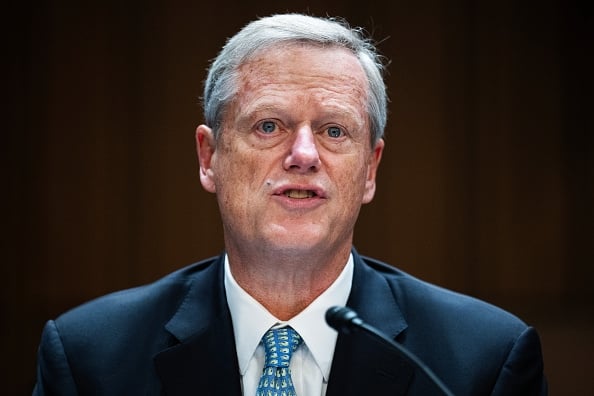You have /5 articles left.
Sign up for a free account or log in.

Charlie Baker, president of the NCAA, testifies before Congress in October.
The National Collegiate Athletic Association was born more than 100 years ago in response to criticism that college sports was out of control in ways that put athletes at risk. Ever since, most changes to intercollegiate athletics and the association primarily responsible for overseeing it have been driven by external pressure—up to and including a proposal the NCAA’s new head, Charlie Baker, floated Tuesday.
“The courts and other public entities continue to debate reform measures that in many cases would seriously damage parts or all of college athletics,” Baker said in a letter to leaders in Division I, the NCAA’s highest competitive level. “Therefore, it is time for us—the NCAA—to offer our own forward-looking framework.”
The plan Baker laid out after months of study would allow all Division I institutions to directly compensate athletes for use of their name, image and likeness.
It would also create a new subdivision for the richest and most powerful programs that would give them significantly more autonomy over how they spent their money, as long as they agree to “invest at least $30,000 per year into an enhanced educational trust fund for at least half” of their athletes.
Sportswriters and commentators described Baker’s plan as “groundbreaking” and “revolutionary,” and in certain ways it would be. It would pierce a historical barrier, self-imposed by the NCAA, that has prevented colleges from paying athletes directly over and above the costs of their educations.
And it would acknowledge the long-standing thirst of the association’s 40 to 60 most powerful football-playing members for more control over their own fates, separating them more formally from the 200 to 300 other institutions that also compete in Division I basketball, and even from the rest of the 130-odd universities that currently play in the Football Bowl Subdivision.
But it is also clearly a nod to the reality that the NCAA is hanging on to its authority over college sports by a thread: an attempt both to discourage Congress and the courts from undermining its authority further, and to deter the biggest programs from walking away from the NCAA altogether and forming their own freestanding association.
“What Ross calls ‘revolutionary,’ I call belated and reactionary,” Marc Edelman, a professor of law at Baruch College, said in response to a characterization of Baker’s proposal by Yahoo’s Ross Dellenger. “This association, the #NCAA, ignores experts in the field and does nothing to promote reform until their backs are legally against the wall. Right now, their backs are legally against the wall and Baker knows it.”
Karen Weaver, an adjunct assistant professor at the University of Pennsylvania who writes widely about college athletics, described Baker’s proposal as “a way to keep the organization together under the NCAA umbrella … while giving enormous flexibility and almost unchecked spending to the highest-profile schools.”
A Full Plate of Problems for Baker
The list of issues and problems facing the NCAA is long, including legal and political challenges to the association’s authority; the turmoil and divisions created by the confusing landscape of name, image and likeness payments; and the cutthroat institutional behavior tied to conference realignment.
The NCAA hired Baker, a Republican who was previously governor of Massachusetts, as its first-ever leader who lacked any professional background in athletics in part to help it navigate that political and legal landscape.
The most immediate dilemma facing Baker and the NCAA involves the compensation of athletes, which is the subject of multiple lawsuits and legislation in Congress.
The plan he shared with college leaders Tuesday said it was first and foremost essential that the NCAA “make it possible for all Division I colleges and universities to offer student-athletes any level of enhanced educational benefits they deem appropriate. Second, rules should change for any Division I school, at their choice, to enter into name, image and likeness licensing opportunities with their student-athletes.”
Bringing the name, image and likeness payments under the colleges’ control would, among other things, “help level what is fast becoming a very unlevel playing field between men and women,” Baker said, because “schools will be required to abide by existing gender equity regulations as they make investments in their athletics programs.”
The NIL ecosystem that is developing now, which involves quasi-independent “collectives” of donors supporting specific colleges, is creating enormous inequity between sports programs and largely supporting athletes in a handful of sports, mostly for men.
The other major element of Baker’s proposal—creating a new subdivision for institutions “with the highest resources”—is a warmed-over idea that the universities with the largest and wealthiest sports programs have been proposing on and off for more than 40 years (and most recently about a decade ago).
They have long felt hamstrung by having to make certain decisions alongside less wealthy programs that want to limit how much sports programs spend on scholarships, coaching staffs and other things. Baker’s letter said the proposed subdivision would let those wealthy programs “create rules that may differ from the rules in place for the rest of Division I” on such things as “scholarship commitment and roster size, recruitment, transfers, NIL.”
In exchange, programs opting in to the new subdivision would have to commit to putting at least $30,000 a year into a trust fund for at least half of their athletes, “within the framework of Title IX,” the federal law that requires gender equity in educational programs, including athletics.
The NCAA’s largest and wealthiest programs have slowly been segregating themselves already, through the process of conference realignment that has led to accusations of backstabbing among some of the country’s most visible universities.
Many observers have speculated that the logical endgame of that winnowing process is a few dozen universities setting up their own megaconference(s), possibly outside the control of the NCAA, in ways that would allow them to share television resources only among themselves and, possibly, undermine not only the NCAA’s extremely lucrative Division I basketball tournaments but also the association itself. The Knight Commission, a sports reform group, several years ago endorsed a version of this proposal that would create a separate organization to govern big-time college football and a playoff tournament but leave the sports powers within the NCAA for all other sports.
Several commentators Tuesday saw Baker’s plan as a gambit to avoid such an outcome and keep the NCAA together. They were mixed on the prospects of its success.
Walter Harrison, former president of the University of Hartford and a longtime key participant in the NCAA’s governance process, said he sensed the “hidden but strong hand” of the so-called Power Five conferences at work in Baker’s proposal. “Their answer,” Harrison said via email, “is to create a subdivision that ‘pays’ all players. It also means that all member institutions will continue to underwrite all the costs of big-time football administration (enforcement, rules, academics, etc.), while the big-time football schools reap the windfall of [the expanded playoff structure]. On the surface, that looks unfair.”
He also expressed doubt that the NCAA’s men’s and women’s basketball tournaments would survive under Baker’s proposed structure, since the football powers “will be paying athletes, while others won’t (at least won’t be paying them as much). That will be a shame for us fans, and may mean the NCAA may not survive at all.”
Weaver, the Penn professor who was an athletics director before she became an academic, said that Baker’s proposal, if it came to pass, would “force the issue for hundreds of Division I campuses who do not have the resources” to afford the investments Baker would require members of the new subdivision to make.
That includes some of the universities now in the top conferences, she said, adding, “There will be some difficult conversations on campuses in the near future.”









